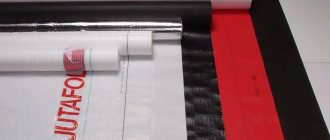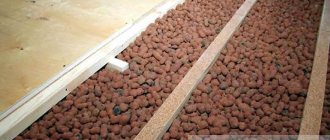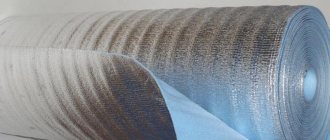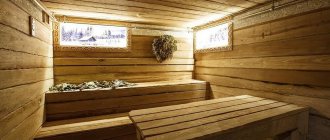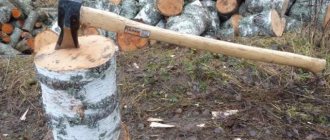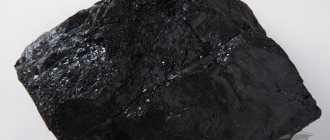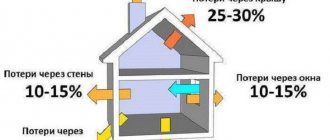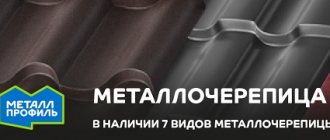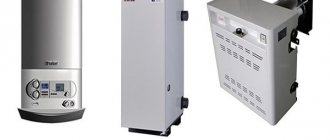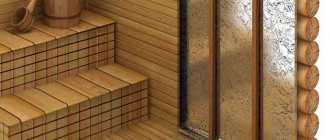The installation of a vapor barrier is an important stage in construction necessary to protect against the effects of water vapor on the insulation. The absence of such a layer during sudden temperature changes contributes to the deterioration of the characteristics of most building materials and a reduction in their service life. Moisture ingress also causes mold to appear on them.
Vapor barrier is installed using a variety of materials both from the outside and from the inside of the house. During installation, compliance with technology is required, as well as rules on which the quality of the finished work directly depends.
The principle of operation of vapor barrier in general
The main task is to create an obstacle to the permeability of vapors. Thanks to this property, the walls are protected from destruction from accumulated moisture (condensation). But the very definition of “vapor barrier” does not mean that the film creates a barrier and completely interferes with the circulation of steam. Modern materials are aimed at providing a slight air flow to eliminate the greenhouse effect in the house itself.
Where vapor barrier is needed
There is a category of premises where installing a vapor barrier is a mandatory measure. Such cases include the following:
- Premises with high temperatures and high air humidity, in particular baths and basements;
- The use of materials that become wet due to high humidity and lose all the characteristics declared by the manufacturer, deteriorating over time, for example, glass wool and mineral wool;
- In the construction of multilayer walls of frame houses, since condensation is likely to occur between the layers;
- When installing ventilated facades, in this option the vapor barrier makes the air flow weaker, protecting the insulation from excessive load, for example, a brick wall with cotton insulation and sheathed with siding.
Let's sum it up
A wall vapor barrier is always needed if the structure is insulated. This is necessary to avoid moisture condensation inside the insulation cake.
How to make a vapor barrier:
- If the house is insulated from the outside, the vapor barrier is attached directly to the wall on one side. If there is interior decoration, it will be from the inside. If not, then on the outside of the wall.
- When insulating a house from the inside, a vapor barrier is always mounted on the wall from the inside. But in this case, it is extremely important that it fits tightly to the surface and is airtight.
Polyethylene
Traditionally available material with a thickness of only 1 mm. It should be fastened with concentration and care to prevent excessive tension, which could damage the film due to temperature changes.
There are several types of film protection:
- Perforated with small vapor-permeable holes;
- Non-perforated.
In the absence of perforation, along with steam, the flow of air is also limited, which affects the acceptable microclimate in the room. Polyethylene is practically not used at present, as there are more modern materials.
Membrane films
The base of the vapor barrier membrane is polypropylene, with fiberglass mesh. The rough surface of the film creates a barrier that does not allow moisture to pass into both the wall and the insulation.
Due to the fact that the membrane is multi-layered, it stops not only the permeability of moisture, but also allows a small amount of air to pass inside.
Advantages:
- Can be used for wooden and frame houses;
- No need to create an air gap;
- Easy installation;
- Strength;
- Resistance to an increase in the number of mold microorganisms on the surface of the walls;
- Resistance to putrefactive processes;
- The material is harmless to humans;
- Extended service life - the film retains the original properties declared by the manufacturers for 50 years;
- Large temperature coverage during operation (from -60 to +80 °C);
- The presence of types of membranes reinforced with a layer of foil, which will reflect the heat coming from the house.
How to install a vapor barrier on a wall
This type of installation is often used if mineral materials are used as thermal insulation. As a result, a multilayer structure appears, consisting of such layers as:
- External cladding;
- Windproofing;
- Insulation;
- Frame;
- Vapor barrier;
- Interior decoration.
Attention! It is strictly forbidden to attach a vapor barrier to both sides of the insulation at once - this leads to the formation of condensation due to a violation of the natural insulation.
The correct order guarantees a long service life of the insulation and the house as a whole. The process consists of several stages:
- Installing the film and securing it to the sheathing;
- Sizing of formed cracks, overlaps and puncture sites;
- Installation of sheathing using beams to provide ventilation;
- Sheathing with finishing materials, such as plasterboard or panels.
Which side to attach the vapor barrier to the insulation
If both surfaces of the material are the same, then it does not matter which side to attach the vapor barrier material - this will not affect the protective function. If one of them is rough, then it should be the one that “faces” the house; thanks to such a surface, droplets of condensation are retained.
The foil membrane fixes the shiny surface inside the room - this helps retain heat in the room.
Film materials - smooth side to the insulation.
Criteria for choosing a vapor barrier material
When choosing a material, you should pay attention to several important criteria, including the following:
- Vapor permeability, the ability to absorb moisture and let air pass through is one of the most important factors; it is measured in g/m2 per day;
- Life time. Cheap materials can tear very quickly; membranes made of non-woven artificial fibers show the best indicator of this criterion;
- Difficult to install. When choosing, you should find out how the material is attached (what kind of overlap is made, and what tapes are needed); it must be attached tightly to the insulation, or leave a gap;
- Price. Products for this purpose are sold in rolls. In a store, they usually pay attention only to the price, but do not take into account that rolls come in different sizes; in order to sensibly assess the cost, you need to compare these two factors and calculate the real price.
The ability to absorb moisture and allow air to pass through is one of the most important factors.
How is vapor barrier attached?
Fixation is done in several ways:
- Nails with wide heads;
- Construction stapler;
- A lathing of wooden sticks at a certain distance.
Vapor barrier of frame structures
A layer of vapor barrier in a frame house may not be needed. This happens when using such insulation - ecowool, polyurethane foam, polystyrene foam, and provided that an effective ventilation system is created.
If the need for installation does arise, then one of the two schemes given below is used. It is chosen based on the expected intensity of use of the premises in a certain season:
1 scheme:
- The vapor barrier is attached to the frame posts;
- The walls are covered with clapboard, plasterboard or other interior finishing materials.
This method is used in buildings for the warm season, without being in them during the cold season. For example, a dacha, a workshop, a summer guest house.
2 scheme:
- Installation of horizontal or vertical sheathing located 30-50 mm from the wall to create an air gap;
- Fastening the membrane under the sheathing side exclusively indoors when using a construction stapler;
- Taping the joints with construction tape.
The scope of application of this method is for buildings with active use in the winter season.
Peculiarities
Before installing the vapor barrier, the following features must be taken into account:
- Material. By studying the technical characteristics of the material, you can understand how suitable it is for working indoors or outdoors.
- Correctness of work. In addition to the fact that the rolled material is laid with an overlap of at least 20 cm, you need to know which side and in what method: vertically, horizontally.
- The joints of the material must be glued to avoid moisture getting on the insulation.
- The material is fixed every 60 cm.
For quality work done, craftsmen recommend purchasing vapor barrier and its components from the same company. Let's say that the tape for the joints should be of the same brand as the material itself.
Vapor barrier of the walls of a house can be carried out not only when a new building is being built, but also during renovation work. The walls of the house are destroyed under the influence of moisture, so to preserve them, the material is installed outdoors and in the house. Only in some cases is work carried out on one side (frame house). Having studied all the nuances of installation, the vapor barrier will last a long time, and the microclimate in the house will not be disturbed by moisture.
Vapor barrier in wooden houses
Wood is a material that requires mandatory vapor protection due to the passage of air and the absorption of excess moisture, which causes its swelling.
Since logs shrink during the first 5 years, when installing a vapor barrier, you must adhere to the following rules:
- Before using laminated veneer lumber, it must be dried as best as possible;
- There should be grooves on the timber so that over time, during drying, the material becomes compacted to minimize the formation of steam.
If shrinkage has occurred for less than 5 years, then membranes of the type “Izospan B”, “Izospan FB”, “Izospan FS” are used.
Vapor barrier installation on the outside of a wooden house
The sequence is:
- The vapor barrier layer is laid directly on the wall;
- A sheathing made of beams or metal profiles is installed;
- Thermal insulation material is placed in the cells of the sheathing;
- Finishing in the form of siding and other types of materials.
This method is suitable for rectangular timber.
Vapor barrier device inside a wooden house
The method of installing a vapor barrier from the inside of a room is suitable for preserving the appearance of a wooden house. Produced in the following sequence:
- Insulation is laid between the wooden beams;
- The vapor barrier film is attached to the sheathing using a special stapler;
- After fastening, seal the membrane joints with mounting tape;
- The interior decoration of the room is installed on the vapor barrier layer.
This technology is used when using cylindrical timber.
General rules for installing a vapor barrier film for a wooden house:
The film is stretched tightly without sagging, overlapping by about 10 cm. To connect them together, adhesive tapes are used.
Preparatory work
Before installing the insulating layer, you should select a material taking into account the characteristics of its installation process. For example, when working in a wooden house, all materials must undergo protective treatment with antiseptic agents and fire retardants.
Before attaching the vapor barrier to the insulation layer of the internal walls, dismantling work should be carried out to clean the surfaces from the remnants of previous finishing materials. Cleaned natural wood surfaces are treated with compounds to prevent burning and rotting. Concrete or block buildings should also be treated with a deep penetration antiseptic compound.
When insulating brick walls from the outside, it is recommended to carefully eliminate all cracks and cracks. And after this, treat the surfaces with an antiseptic solution. Only on completely cleaned surfaces can leveling mixtures be applied and a vapor barrier coating system installed.
Ceiling vapor barrier
For the ceiling, you can also use materials with foil surfaces. They are laid with the heat-reflecting side inside the room for better heat retention. Fastenings are made using nails with wide heads, and the joints are additionally insulated with tape.
It is necessary to lay a layer of vapor barrier on the ceiling on laid layers or rolls of insulation, previously laid in the spaces between the joists and rafters. If the thickness of such insulation is equal to the height of the logs, it may be necessary to install a slatted counter-lattice to maintain a constant level of ventilation. In this case, you need to fasten it correctly: with a slight overlap on the walls around the perimeter. Particular attention should be paid to the corners: we fix the film with an overlap and tightly.
Roof vapor barrier
It is better to choose a membrane film for the roof. How to properly install such a vapor barrier? Place the smooth side on the insulation. To prevent steam particles from penetrating through the mounting holes, it is recommended to fasten the insulation directly to the wooden beams with a staple gun. This ensures the tightest possible fit. Therefore, perforated films are not used for vapor barrier of roofs and ceilings.
There are films with an anti-condensation coating that are placed under materials susceptible to rust (galvanized steel, corrugated sheets or metal tiles). This film can protect metal surfaces from moisture droplets. Such materials are laid with the fabric side down at a short distance from the layer of mineral wool or any other insulation. It is possible to lay two layers of film with anti-condensation treatment.
External vapor barrier of the walls of the house is necessary to combat atmospheric moisture, which can destroy the insulating material. It is important to make a double vapor barrier layer of insulation. This will cover all the joints of the sheets and provide more reliable protection from steam and unnecessary moisture.
